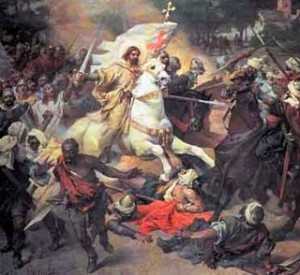When Spanish troops arrived in Iraq in 2004 to help the allied occupation of the country, they looked much like any other force of Western troops, wearing uniform and wielding guns. But a closer look showed them wearing something that spoke very clearly of their Spanish identity and history: the red cross of Santiago Matamoros, or Saint James the Moorslayer.

It was a crass gesture, given the Muslim enemy they were going to fight, but Spain and particularly its military have used St James as a symbol of inspiration in different guises for the last 1,200 years. July 25 is the feast day of Spain’s patron saint, when he and the extravagant legend surrounding his afterlife are celebrated.
James’s life itself was noteworthy, given that, according to the Bible he was a fisherman who became one of the favourite disciples of his cousin Jesus. After Jesus’s death, it is claimed that James travelled to the Iberian Peninsular to spread Christianity, before returning to the Holy Land, where Herod Agrippa had him beheaded. It is after his death that the legend starts straying deep into the supernatural. The saint’s followers placed his corpse on a small boat that floated unguided across the Mediterranean, through the Straits of Gibraltar before stopping on the Atlantic shores of Galicia. The whole trip supposedly only took a week, prompting the 19th century writer Richard Ford to comment archly that “the Oriental Steam Company can do nothing like it.”
The legend continues with James’s body eventually resting in a field in northwestern Spain, where it remained until the ninth century. A wandering hermit was mysteriously drawn to some stars shining above the field and when the local bishop was brought to look, it was declared that the apostle St James was buried there. The field of stars – or “campus stellae” – then became the site of a chapel, a church, a cathedral and then a city: Compostela. By then, the relics of the saint were already drawing Catholics from across Europe.
But his discovery in Galicia some 800 years after his death does not appear to have been sheer coincidence. At the time, almost the entire country, except for the northwest, was occupied by the Moors and the Christians were desperately in need of some military inspiration as they sought to reconquer.
James provided that inspiration at the Battle of Clavijo, in 844, when his appearance on the battlefield astride a white horse struck fear into the hearts of the Muslims and filled the Christians with hope. Matamoros was born. Sophia Deboick, a historian of popular religious culture who specialises in sainthood, explains how elements of James’s character were particularly useful when his warrior persona was being constructed.
“The Gospel tells us that he was a Galilean fisherman, that he’s got something of a temper and he and his brother St. John are known as Sons of Thunder,” she told Iberosphere. “And this perhaps, feeds into his representation in medieval Spain, which is under Muslim dominance, and we find Christian Spaniards remoulding the St James of the Gospel into St James the Moorslayer.”
Another incarnation for Santiago
But while the Spanish Church claimed this Galilean as its own and replaced his fishing net with a broadsword, his transformation did not end there. Deboick explains that Latin American indigenous populations, who themselves saw the Spaniards as an oppressive occupying presence, recast him as their own miraculous figure. In Peru, he even became known as “St James the Slayer of Spaniards”.
“He is taken on and changed by each society that venerates him to suit their own particular purpose,” explains Deboick.
Since then, Santiago has been presented as a less war-like saint, and generally depicted as a pilgrim in a wide-brimmed hat, holding a staff and with the scallop shell that represents the pilgrimage to the city that bears his name. The Spanish army’s use of his red cross in Iraq notwithstanding, the thunderous warrior has become a wise, humble figure, who inspires armies of pilgrims, not soldiers. Pilgrim, warrior, Iberian evangeliser; St. James has come a long way from the fishing boats of Galilee over the last 2,000 years.
Santiago is not a Moor slayer in Santiago Cathedral. So as not to disturb the sensitivities of the numerous Muslim visitors to a Catholic church, the famous statue of him on horseback, trampling and lancing Moors, is obscured by a bank of irises. All you can see is him a-horseback, looking down toward the point of the lance he’s apparently wielding to no purpose. Your picture of Santiago would never be allowed in Santiago.
BTW – Leaving aside the ridiculous myth of an empty STONE boat turning up at Padrón with the corpse of St James in it, there’s not a single scrap of evidence that James ever came anywhere near Spain, never mind Galicia. But what a wonderful marketing ploy it’s all been for the region for more than a thousand years now. Wish I had some rights/shares in it!